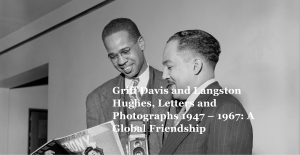
Two concurrent exhibits—one at UCF and one at the Florida Museum of Photographic Arts in Tampa—use photographs to explore themes of black community, friendship and resilience in the face of systemic violence and discrimination.
The first exhibit, “Zora Neale Hurston’s ‘Native Village’: Historic Eatonville Remembered,” hosted on the first-floor gallery wall in UCF’s John C. Hitt Library, runs through February. Curated by Associate Professor of History and Director of Public History Scot French, the exhibit presents photographs taken by the renowned African American author and anthropologist Zora Neale Hurston and her colleagues Alan Lomax and Mary Louise Barnicle during their research trip to Eatonville in 1935. The exhibit explores the research trip as well as Hurston’s deep personal relationship with the Eatonville community. It demonstrates how Hurston incorporated material gathered during her travels into her celebrated works of literature, autobiography and folklore, most notably Mules and Men.
The author spent her formative years as a child in Eatonville, ca. 1892-1904, and the 1935 trip proved personally and professionally meaningful for her. French hopes visitors will identify with Hurston and encourages the UCF community to explore Eatonville “through Hurston’s eyes and ears.”
The second exhibit, Griff Davis and Langston Hughes, Letters and Photographs 1947 – 1967: A Global Friendship, explores the decades-long friendship between renowned poet and thinker Langston Hughes and photographer and journalist Griff Davis. The exhibit runs from through April 19 at the Florida Museum of Photographic Arts (FMoPA) in Tampa and is co-sponsored by Africana Studies at UCF.
Hughes was a prominent member of the Harlem Renaissance, innovator of jazz poetry and a central figure in American literary life. Working as an instructor at Atlanta University in the late 1940s, he befriended his student Griff Davis. This friendship continued in long-distance form until Hughes’ death in 1967. During this time, Davis engaged in a pioneering career in journalism, photographing important events such as the first meeting between Martin Luther King, Jr. and then-Vice President Richard Nixon in 1957. He would serve as the first roving reporter for Ebony Magazine and as a U.S. Foreign Service Officer for thirty-five years in Liberia.
The exhibit features several of Davis’s photographs as well as personal correspondence with Hughes, affording visitors a unique window into their relationship. Davis’s daughter, Dorothy Davis, spoke about her father’s life, career, and friendship with Hughes at the James Weldon Johnson Lecture Series, held at UCF in 2018.
Considered together, and unlike much surviving media from the period, these exhibits constitute a body of representations that are not driven by dehumanizing racial tropes and stereotypes. They depict African Americans as citizens: forging relationships and communities, and pursuing personal and professional goals.